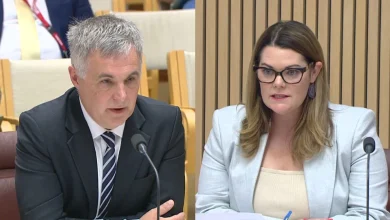‘A partisan ambush’: Albanese maintains the Whitlam rage

“Make no mistake: November 11th, 1975, was not a ‘constitutional crisis’, it was a partisan political ambush. There was no real precedent, and no legitimate pretext,” he said.
Loading
“The opposition orchestrated a parliamentary gridlock over the budget and then secretly prevailed upon the governor-general to break it by sacking the prime minister.
“While the scenes in this building on 11 November may have been chaotic, the dismissal was a calculated plot, hatched by conservative forces which sacrificed conventions and institutions in the pursuit of power.
“And the result of the election that followed does not wash any of that away.”
Albanese admitted the Whitlam government was not perfect, noting the opposition had “preyed” on Kerr’s desire to be at the centre of events while cultivating his paranoia that the prime minister was about to sack him.
But he said the government still had a majority in the House of Representatives and was just a year into its second term.
“In those circumstances, the decision as to when to call an election should belong to the prime minister, not the opposition, not the governor-general,” he said.
Anthony Albanese says the dismissal of the Whitlam government was a partisan political ambush.Credit: AAP/Archive
“And in precisely the same way, the choice as to whether a new government is formed, belongs to the people of Australia.
“Behind all the various schemes and subplots that will be unpacked and revisited tomorrow lies an overt refusal to respect the mandate or even acknowledge the legitimacy of a Labor government that had secured a majority in two consecutive federal elections inside three years.”
Loading
The statue of Whitlam will join a growing number of permanent memorials to past political giants in central Canberra. It will be within sight of the most recent statue, that of the first women to sit in parliament, Dorothy Tangney and Dame Enid Lyons, and not far from a bronze memorial of John Curtin and Ben Chifley.
Other statues in the parliamentary area include representations of Sir Robert Menzies, Edmund Barton, John McEwen and Neville Bonner.
Albanese said the statue would celebrate the ability of democracy to change the nation for the better.
“Australians will be able to stand with Gough, put an arm around the great man’s shoulders, and remind ourselves that if we maintain our enthusiasm, it’s always time,” he said.
The statue will not be the first memorial to Whitlam in Canberra. In line with past prime ministers, a suburb in the city’s west is being established. It includes a children’s playground called the Blue Poles Park to honour the Whitlam government’s purchase of the famous Jackson Pollock artwork.
Cut through the noise of federal politics with news, views and expert analysis. Subscribers can sign up to our weekly Inside Politics newsletter.





